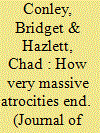| Srl | Item |
| 1 |
ID:
178735


|
|
|
|
|
| Summary/Abstract |
Understanding how the most severe mass atrocities have historically come to an end may aid in designing policy interventions to more rapidly terminate future episodes. To facilitate research in this area, we construct a new dataset covering all 43 very large mass atrocities perpetrated by governments or non-state actors since 1945 with at least 50,000 civilian fatalities. This article introduces and summarizes these data, including an inductively generated typology of three major ending types: those in which (i) violence is carried out to its intended conclusion (37%); (ii) the perpetrator is driven out of power militarily (26%); or (iii) the perpetrator shifts to a different strategy no longer involving mass atrocities against civilians (37%). We find that international actors play a range of important roles in endings, often involving encouragement and support for policy changes that reduce mass killings. Endings could be attributed principally to armed foreign interventions in only four cases, three of which involved regime change. Within the cases we study, no ending was attributable to a neutral peacekeeping mission.
|
|
|
|
|
|
|
|
|
|
|
|
|
|
|
|
| 2 |
ID:
153692


|
|
|
|
|
| Summary/Abstract |
Does the African Union (AU) have an anti-atrocities strategy, and if so, how would one recognize it and assess its impact? This paper proposes two manners of responding to these questions. In this first instance, we can analyse whether the AU has implemented an anti-atrocities agenda that resembles efforts elsewhere, notably at the United Nations. Another approach would be to examine what distinct strategies, strengths, and capacities that the AU brings to the work of reducing threats of mass violence against civilians. This second approach reveals how the AU has innovated a politics of protection. Assessing the AU as both implementer and innovator of protection suggests a more complex picture of the organization’s strengths and weaknesses than assessing either role alone, and reveals that overemphasizing the importation of an agenda developed elsewhere may ultimately undermine the organization’s core capacities.
|
|
|
|
|
|
|
|
|
|
|
|
|
|
|
|